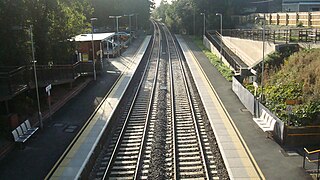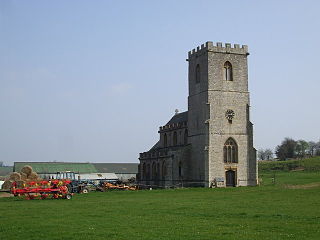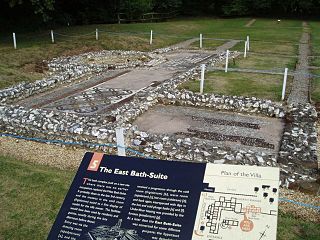
Keynsham is a town and civil parish located between Bristol and Bath in Somerset, England. It had a population of 19,603 at the 2021 Census. It was listed in the Domesday Book as Cainesham, which is believed to mean the home of Saint Keyne.

Durnovaria is a suggested spelling for the Latin form of the name of the Roman town of Dorchester in the modern English county of Dorset, amended from the actually observed Durnonovaria. Upon the assumption that the name was originally Brythonic, it is suggested that the first element in the name, *durno- may mean "fist" like and the second may be related to Old Irish fáir ~ fóir denoting a confined area or den. A simpler amendment would lead to *Duronovaria, making this place one of up to 18 ancient British names that contain Duro- and mostly occur at river crossings, while -novaria has two possible ancient parallels in Britain associated with river junctions. That analysis would perfectly fit the geographical situation of Dorchester.

Keynsham railway station is on the Great Western Main Line in South West England, serving the town of Keynsham, Somerset. It is 113 miles 63 chains (183.1 km) down the line from London Paddington and is situated between Oldfield Park and Bristol Temple Meads stations.
Gioiosa Ionica is a town and comune in Italy in the province of Reggio Calabria, region of Calabria. It lies near the east coast of Calabria and covers an area of 35 square kilometres (14 sq mi).

Chedworth Roman Villa is located near Chedworth, Gloucestershire, England and is a scheduled monument. It is one of the largest and most elaborate Roman villas so far discovered in Britain and one with the latest occupation beyond the Roman period. The villa was built in phases from the early 2nd century to the 5th century, with the 4th-century construction transforming the building into an elite dwelling arranged around three sides of a courtyard. The 4th-century building included a heated and furnished west wing containing a dining-room (triclinium) with a fine mosaic floor, as well as two separate bathing suites: one for damp-heat and one for dry-heat.

Low Ham is a village in the civil parish of High Ham in the English county of Somerset.
Vacone is a comune (municipality) in the Province of Rieti in the Italian region of Latium, located about 20 kilometres (12 mi) west of Rieti.

Rockbourne Roman Villa is a Roman courtyard villa excavated and put on public display in the village of Rockbourne in the English county of Hampshire. The villa was discovered in 1942 by a local farmer and excavated by A. T. Morley Hewitt over the next thirty years.

Littlecote Roman Villa is an extensive and exceptional Roman villa, with associated religious complex, at Littlecote Park just over a mile west of Hungerford, Berkshire. It has been excavated and is on display to the public in the grounds of the estate.

The Low Ham Roman Villa was a Roman courtyard villa located near Low Ham in the civil parish of High Ham in the English county of Somerset. It is best known for the extraordinary figured mosaic depicting the story of Aeneas and Dido.

Somerdale was a chocolate factory located in Keynsham near Bristol in South-west England, closed by Kraft foods in 2011. It was the home of a Cadbury plc production facility, and was originally built by the Fry family when they expanded through consolidation of a number of existing facilities located in the centre of Bristol.

Newport Roman Villa was a Romano-British farmhouse constructed in 280 AD. It is located near to Newport, Isle of Wight.

Keynsham Abbey in Keynsham, Somerset, England, was a monastic abbey founded c. 1166 by William, Earl of Gloucester. The abbey was established as a house of Augustinian canons regular, and operated until the dissolution of the monasteries in 1539.

The Domus Romana, stylized as the Domvs Romana, is a ruined Roman-era house located on the boundary between Mdina and Rabat, Malta. It was built in the 1st century BC as an aristocratic town house (domus) within the Roman city of Melite. In the 11th century, a Muslim cemetery was established on the remains of the domus.

A Roman mosaic is a mosaic made during the Roman period, throughout the Roman Republic and later Empire. Mosaics were used in a variety of private and public buildings, on both floors and walls, though they competed with cheaper frescos for the latter. They were highly influenced by earlier and contemporary Hellenistic Greek mosaics, and often included famous figures from history and mythology, such as Alexander the Great in the Alexander Mosaic.

The Cheddar Palace was established in the 9th century, in Cheddar, Somerset, England. It was a royal hunting lodge in the Anglo-Saxon and medieval periods and hosted the Witenagemot in the 10th century.

Folkestone Roman Villa, also referred to as the East Bay Site, is a villa built during the Roman Occupation of Britain, and is located in East Wear Bay near the port town of Folkestone, in Kent, England. The villa is situated on a cliff top overlooking the English Channel, with views of the French coast at Boulogne on a clear day. It is situated near the start of the North Downs Trackway, and the area has been inhabited for thousands of years, with archeological finds in the area and at the villa site dating back to the Mesolithic and Neolithic ages. The villa was built around A. D. 75, and was almost certainly built within the confines of a preexisting Iron Age settlement.

The Keston Roman villa is an archaeological site in Keston in the London Borough of Bromley, England. The villa consisted of several buildings including a mausoleum. The latter is preserved above ground.
At Eccles in Kent the remains of a huge Roman Villa with palatial dimensions were excavated between 1962 and 1976. In the second century AD, the villa was almost 112 m long. Over 135 different rooms have been identified throughout the various periods of construction and reconstruction. The villa was abandoned in the Fourth century and much of it was removed in the Thirteenth century for the construction of Aylesford Priory.

Dalton Parlours Roman villa is a Roman villa and scheduled monument near Collingham, West Yorkshire.




















